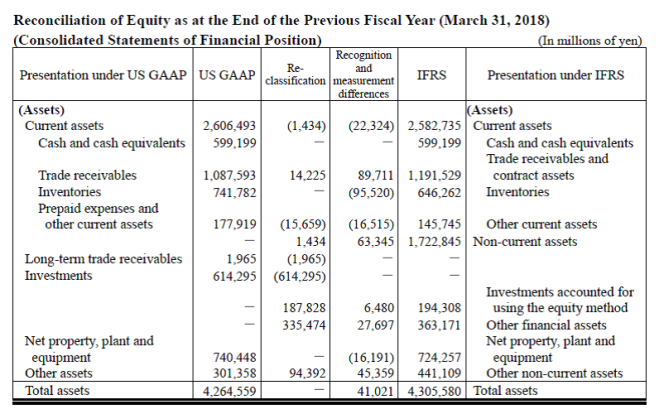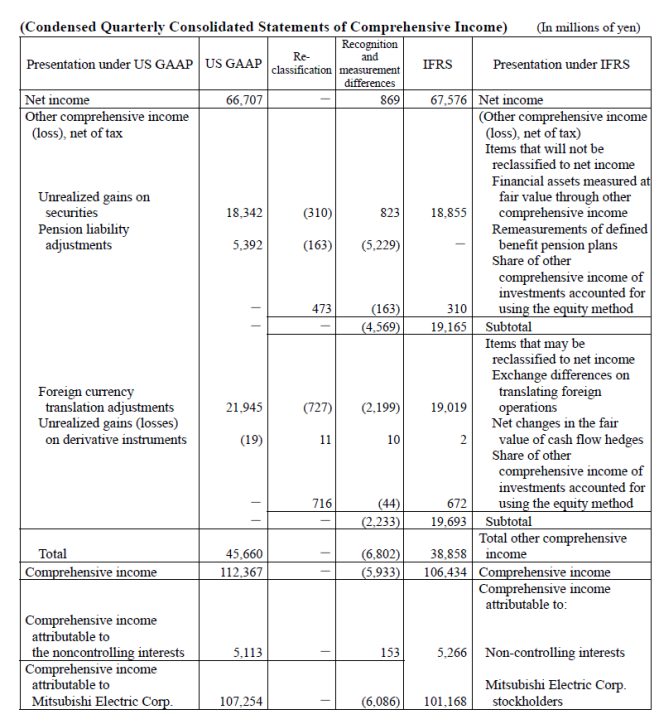Mitsubishi Electric Corporation – Half year results – 30 September 2018
Industry: manufacturing
Disclosures of Transition to IFRS
The Mitsubishi Electric Group has applied IFRS beginning with the consolidated financial statements for the first quarter of the current fiscal year. The most recent consolidated financial statements prepared in accordance with US GAAP are for the one-year period ended on March 31, 2018. The date of transition to IFRS was April 1, 2017.
(1) Exemptions and exceptions in IFRS 1
IFRS 1 requires entities adopting IFRS for the first time to retrospectively apply IFRS in principle; however, with regard to certain items, it allows exemption from, or prohibits, retrospective application of IFRS.
The Company and its consolidated subsidiaries use the following exemptions on retrospective application permitted by IFRS 1:
- Business combinations
The Company and its consolidated subsidiaries elected not to apply IFRS 3 Business Combinations retrospectively to past business combinations that occurred on or before December 22, 2015. Consequently, the amount of goodwill that arose from business combinations occurred on or before December 22, 2015 is recorded at the carrying value in accordance with US GAAP. This goodwill was tested for impairment at the transition date irrespective of whether there was any indication of impairment.
- Exchange differences on translating foreign operations
The Company and its consolidated subsidiaries elected to deem the cumulative translation differences for foreign operations at the transition date to be zero. Consequently, the cumulative translation differences for foreign operations at the transition date were transferred from accumulated other comprehensive income (loss) to retained earnings.
- Designation of financial instruments recognized before the date of transition to IFRS
The Company and its consolidated subsidiaries elected to determine the classification of financial instruments on the basis of the facts and circumstances that exist at the date of transition to IFRS.
(2) Reconciliations
Reconciliations for which disclosures are required on first time adoption of IFRS are as follows:
Items that do not affect retained earnings and comprehensive income are presented in “Reclassification,” and items that affect retained earnings and comprehensive income are presented in “Recognition and measurement differences.”






Notes to reconciliation of equity
The principal effects of transition to IFRS in the reconciliation of equity above are as follows:
(1) Reclassification
The main elements of reclassification are as follows:
(a) In accordance with the presentation provisions under IFRS, other financial assets are presented separately.
(b) Part of trade receivables, prepaid expenses and other current assets and other assets, etc. are reclassified based on the definition and recognition criteria of IFRS.
(c) Part of trade payables, other current liabilities and other fixed liabilities are reclassified based on the definition and recognition criteria of IFRS.
(2) Recognition and measurement differences
The main elements of recognition and measurement differences are as follows:
(a) Employee benefits
Under US GAAP, actuarial gains and losses and past service costs are deferred in accumulated other comprehensive income, subsequently amortized for a specified future period and recognized in profit or loss. Current service costs, interest costs and expected return on plan assets are recognized in profit or loss for the fiscal year.
Under IFRS, on the other hand, changes resulting from remeasurement of defined-benefit corporate pension plans, defined benefit obligation on lump-sum payment plans and plan assets required by IFRS are recognized in other comprehensive income, and reclassified from accumulated other comprehensive income directly to retained earnings, not through profit or loss. Past service costs arising from plan amendments are fully recognized immediately in profit or loss. Current service costs are recognized in profit or loss. Interest costs are recognized in profit or loss at the amount determined by multiplying the net amount of the defined benefit obligation and plan assets by the discount rate used to determine the present value of the obligation.
(b) Equity instruments
Under US GAAP, non-marketable equity instruments are recognized at their cost. If fair value of equity instruments has decreased and the decrease is considered not to be temporary, impairment loss is recognized for the amount of the cost of the equity instruments in excess of fair value. Gains or losses on the sale of these equity instruments are recognized in profit or loss.
Under IFRS, on the other hand, all equity instruments are recognized at fair value irrespective of whether there is an active market. Since it is permitted to recognize changes in fair value in other comprehensive income, the Company and its consolidated subsidiaries have elected to recognize changes in fair value of equity instruments in other comprehensive income. Accordingly, loss on impairment and gains or losses on the sale of equity instruments recognized in profit or loss under US GAAP are recognized in other comprehensive income as well.
(c) Income taxes
Under US GAAP, tax expenses incurred by sellers are deferred using the deferral method for differences arising from unrealized profits and losses from intercompany transactions.
Under IFRS, on the other hand, a difference between the carrying amount and the sale price of an asset sold is recognized as a future deductible temporary difference based on the asset-and-liability approach. A deferred tax asset is recognized for the future deductible temporary difference using purchaser’s effective tax rate while taking its recoverability into consideration.
Under US GAAP, deferred tax liabilities for temporary differences associated with investments in equity investees are recognized using tax rates applicable on the premise that the temporary difference will be reversed at the time of sale of the equity investees even if a company intends to continue to hold the investments. In principle, deferred tax liabilities are recognized for the undistributed earnings of subsidiaries, etc.
Under IFRS, deferred tax liabilities are in principle recognized for all the taxable temporary differences using tax rates applied when the taxable temporary differences reverse, such as when receiving dividends or selling the investments. Deferred tax liabilities are recognized for the taxable temporary differences associated with investments in subsidiaries etc. which are probable to reverse in the foreseeable future.
(d) Exchange differences on translating foreign operations
Cumulative exchange differences on translating foreign operations are all deemed to be zero at the date of transition to IFRS. Consequently, exchange differences on translating foreign operations included in accumulated other comprehensive income as at the transition date were fully reclassified to retained earnings.
(e) Exclusion of equity investees
Under US GAAP, when an investee no longer qualifies as an equity investee, the difference between the sale price and the carrying amount of the interest sold is recognized in profit or loss. If an investor retains a residual interest, gains or losses recognized in prior periods remain included in the carrying amount of the residual interest.
Under IFRS, on the other hand, when an investee no longer qualifies as an equity investee, the residual interest is measured at fair value if an investor retains a residual interest. The sale price and the difference between the fair value and the carrying amount of the residual interest at the point when an investee no longer qualifies as an equity investee is recognized in profit or loss.
(f) Government grants
Under US GAAP, government grants related to acquisition of assets are not reflected in the carrying amounts of assets because there are no accounting standards for such government grants.
Under IFRS, on the other hand, government grants related to assets are recognized as reducing the carrying amount of the asset by the government grants received.
(g) Impairment of non-financial assets
Under US GAAP, if there is an indication that a fixed asset may be impaired, the carrying amount and the undiscounted estimated future cash flows of the asset is compared. If the carrying amount exceeds the estimated future cash flows, any excess of the carrying amount over the fair value is recognized as an impairment loss.
Under IFRS, on the other hand, if there is an indication that a fixed asset may be impaired, any excess of the carrying amount over the recoverable amount of the fixed asset (the higher of value in use or fair value less costs of disposal) is recognized as an impairment loss of the fixed asset.
(h) Business combinations
Under US GAAP, in business combinations, the acquirer measures the acquiree as a whole (including non-controlling interests) at fair value and goodwill is recognized including the portion of goodwill attributable to the non-controlling interests.
Under IFRS, on the other hand, in business combinations it is permitted to elect to apply either method: the acquirer measures the acquiree as a whole (including non-controlling interests) at fair value and goodwill is recognized including the portion of goodwill attributable to the non-controlling interests; or non-controlling interest is measured as a proportional interest in the fair value of the acquiree’s net identifiable assets and goodwill is recognized only for the acquirer’s share. The Company elected the method of measuring non-controlling interest as a proportional interest in the fair value of the acquiree’s net identifiable assets and recognizing goodwill only for the acquirer’s share. Capital surplus is recognized when non-controlling interests are additionally acquired after the date when control was obtained.






Notes to Reconciliation of Profit or Loss and Comprehensive Income
The principal effects of transition to IFRS in the reconciliation of profit or loss and comprehensive income above are as follows:
(1) Reclassification
The main elements of reclassification are as follows:
(a) In accordance with the presentation provisions under IFRS, financial income and financial expenses are presented separately.
(b) In accordance with the presentation provisions under IFRS, part of other income and other expenses, etc. is included and presented in operating profit.
(c) Unrealized gains (losses) on securities, pension liability adjustments, foreign currency translation adjustments and unrealized gains (losses) on derivative instruments in other comprehensive income that are attributable to equity investees are reclassified in accordance with the presentation provisions under IFRS.
(2) Recognition and measurement differences
The main elements of recognition and measurement differences are as follows:
(a) Reconciliation of sales and cost of sales
Under US GAAP, if amounts of construction contracts cannot be reliably estimated, all construction costs and construction revenue are recognized when the construction is complete.
Under IFRS, on the other hand, revenue from a performance obligation satisfied over time is recognized using the cost recovery method if the outcome cannot be reliably estimated. Revenues using the cost recovery method are only recognized for costs incurred to the extent that it is probable that the cost will be recovered and costs are recognized as expenses in the period in which they are incurred.
(b) Equity instruments
Non-marketable equity instruments are recognized at their cost under US GAAP. If fair value of equity instruments has decreased and the decrease is considered not to be temporary, impairment loss is recognized for the amount of the cost of the equity instruments in excess of fair value. Gains or losses on the sale of these equity instruments are recognized in profit or loss.
Under IFRS, on the other hand, equity instruments are recognized at fair value irrespective of whether there is an active market. Because it is permitted to recognize changes in fair value in other comprehensive income, the Company and its consolidated subsidiaries have elected to recognize changes in fair value of equity instruments in other comprehensive income. Accordingly, loss on impairment and gains or losses on the sale of equity instruments recognized in profit or loss under US GAAP are recognized in other comprehensive income as well.
Notes to Reconciliation of Cash Flows
There are no significant differences in the statement of cash flows resulting from transition from US GAAP to IFRS.